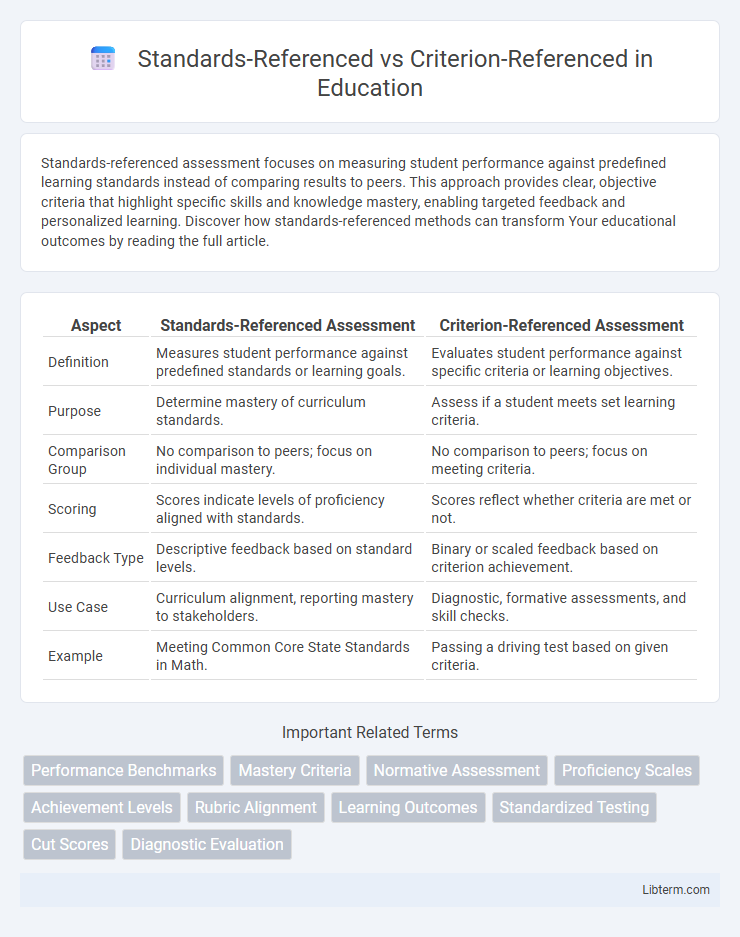Standards-referenced assessment focuses on measuring student performance against predefined learning standards instead of comparing results to peers. This approach provides clear, objective criteria that highlight specific skills and knowledge mastery, enabling targeted feedback and personalized learning. Discover how standards-referenced methods can transform Your educational outcomes by reading the full article.
Table of Comparison
| Aspect | Standards-Referenced Assessment | Criterion-Referenced Assessment |
|---|---|---|
| Definition | Measures student performance against predefined standards or learning goals. | Evaluates student performance against specific criteria or learning objectives. |
| Purpose | Determine mastery of curriculum standards. | Assess if a student meets set learning criteria. |
| Comparison Group | No comparison to peers; focus on individual mastery. | No comparison to peers; focus on meeting criteria. |
| Scoring | Scores indicate levels of proficiency aligned with standards. | Scores reflect whether criteria are met or not. |
| Feedback Type | Descriptive feedback based on standard levels. | Binary or scaled feedback based on criterion achievement. |
| Use Case | Curriculum alignment, reporting mastery to stakeholders. | Diagnostic, formative assessments, and skill checks. |
| Example | Meeting Common Core State Standards in Math. | Passing a driving test based on given criteria. |
Introduction to Assessment Models
Standards-referenced assessment models evaluate student performance against predetermined learning standards, ensuring alignment with specific educational goals and benchmarks. Criterion-referenced assessments measure individual achievement based on mastery of defined criteria, enabling clear identification of skill acquisition and knowledge proficiency. Both models provide structured frameworks for evaluating learning outcomes, guiding instruction, and supporting student growth within educational systems.
Defining Standards-Referenced Assessment
Standards-referenced assessment measures student performance against predefined learning standards or objectives, ensuring alignment with curriculum expectations. This approach provides detailed information on specific skills or knowledge mastered, enabling targeted instruction and personalized learning paths. Clear performance descriptors and benchmarks define achievement levels, supporting transparency and consistency in evaluating student progress.
Understanding Criterion-Referenced Assessment
Criterion-referenced assessment measures student performance against a predetermined set of standards or criteria, providing clear insights into specific skills or knowledge mastery. Unlike standards-referenced approaches, which compare students to each other based on broader benchmarks, criterion-referenced assessments allow educators to identify individual strengths and gaps precisely. This targeted evaluation supports personalized learning and ensures alignment with established educational objectives.
Key Differences Between the Two Approaches
Standards-referenced assessments measure student performance against predefined learning standards, ensuring alignment with curriculum goals and consistent benchmarks across classrooms. Criterion-referenced assessments evaluate a student's proficiency based on specific learning criteria or skill sets, highlighting individual mastery without comparing to peer performance. The key difference lies in standards-referenced focusing on meeting established educational standards, while criterion-referenced centers on achieving particular learning objectives or competencies.
Advantages of Standards-Referenced Assessments
Standards-referenced assessments align student performance with predefined learning objectives, promoting consistent evaluation across diverse classrooms and enhancing instructional clarity. These assessments facilitate targeted feedback, allowing educators to identify specific strengths and weaknesses relative to essential standards. By emphasizing mastery of content rather than relative ranking, standards-referenced assessments support personalized learning and equitable student growth measurement.
Benefits of Criterion-Referenced Assessments
Criterion-referenced assessments provide clear benchmarks that measure a student's mastery of specific skills or knowledge, enabling targeted instruction and personalized learning paths. These assessments promote consistency by evaluating performance against defined standards rather than comparing students to peers, which reduces competition and anxiety. Educators and stakeholders gain actionable insights into individual progress, facilitating effective interventions and improving overall educational outcomes.
Common Applications in Education
Standards-referenced assessment evaluates student performance based on specific learning standards, commonly applied in K-12 education to ensure mastery of state-mandated curricula. Criterion-referenced assessment measures individual achievement against predetermined criteria, widely used in special education and formative assessments to track progress and guide personalized instruction. Both approaches support data-driven decision-making and improve instructional strategies by providing clear benchmarks aligned with educational goals.
Challenges and Limitations
Standards-referenced assessments often face challenges related to aligning broad educational goals with specific learning outcomes, leading to inconsistencies in interpretation and implementation across diverse educational settings. Criterion-referenced assessments are limited by their dependence on clear, measurable criteria, which can restrict the assessment's scope and fail to capture higher-order thinking skills or contextual understanding. Both approaches struggle with balancing fairness and rigor while ensuring validity and reliability in diverse student populations.
Choosing the Right Assessment Method
Choosing the right assessment method hinges on understanding the distinction between standards-referenced and criterion-referenced assessments. Standards-referenced assessments evaluate student performance against predetermined benchmarks or proficiency levels, ideal for measuring mastery of curriculum standards. Criterion-referenced assessments determine whether a student meets specific learning objectives, making them effective for targeted feedback and instructional adjustments.
Future Trends in Educational Assessment
Future trends in educational assessment emphasize a shift towards integrating standards-referenced and criterion-referenced approaches to enhance personalized learning and competency measurement. Adaptive testing technologies and data analytics enable real-time tracking of student mastery against defined standards, fostering targeted interventions. Machine learning algorithms are increasingly employed to refine criterion-referenced evaluations, ensuring precise alignment with evolving curriculum benchmarks and individualized learning trajectories.
Standards-Referenced Infographic

 libterm.com
libterm.com